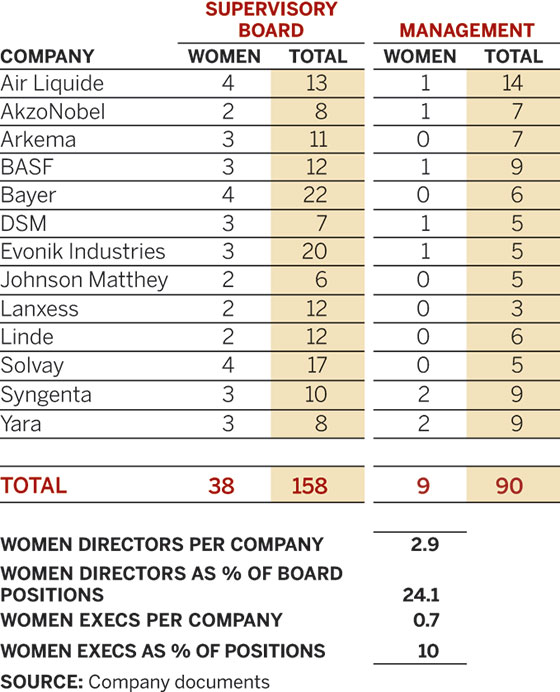Advertisement
Grab your lab coat. Let's get started
Welcome!
Welcome!
Create an account below to get 6 C&EN articles per month, receive newsletters and more - all free.
It seems this is your first time logging in online. Please enter the following information to continue.
As an ACS member you automatically get access to this site. All we need is few more details to create your reading experience.
Not you? Sign in with a different account.
Not you? Sign in with a different account.
ERROR 1
ERROR 1
ERROR 2
ERROR 2
ERROR 2
ERROR 2
ERROR 2
Password and Confirm password must match.
If you have an ACS member number, please enter it here so we can link this account to your membership. (optional)
ERROR 2
ACS values your privacy. By submitting your information, you are gaining access to C&EN and subscribing to our weekly newsletter. We use the information you provide to make your reading experience better, and we will never sell your data to third party members.
Business
Women In Industry
The lack of female representation shows that the chemical industry is still largely a man's world
by Alexander H. Tullo
August 11, 2008
| A version of this story appeared in
Volume 86, Issue 32
THE CHEMICAL INDUSTRY changes quickly for an institution that has been around for more than a century. Mergers and acquisitions ensure that company names come and go. The industry is still creative enough to come up with new technologies that rapidly change the lives of consumers. And globalization is leaving its mark on the how, where, and who of business.
Against this backdrop, there is one area where change has been minuscule: the advancement of women into the upper corporate ranks of chemical companies. As evidenced by C&EN's annual survey of women serving as company executives and directors, male dominance of the industry continues.
Women made some progress in the past year. They comprise 12.1% of 405 directors at 42 publicly traded chemical companies and companies that have significant chemical businesses. This is a modest increase from the 11.5% in the 2007 survey, but it is lower than the 12.8% figure C&EN tabulated in 2003. In addition, an average of 1.2 female directors serve per company, a slight increase from 1.1 in 2007.
However, the survey finds that fewer women are serving as top executives—some 8.1% out of 407 executive officers compared with 8.4% in the 2007 survey. The number of female executive officers per company has remained the same at 0.8.
C&EN gathers the information about the directors from company annual reports and proxy statements. And it counts as executive officers those people listed as such in 10-K filings with the Securities & Exchange Commission. The survey counts directors and executive officers serving at the end of the prior fiscal year.
Two companies listed in the 2007 C&EN survey could not be included this year. Lyondell Chemical was purchased by European chemical maker Basell. And because of the recent divestitures of its plastics and silicones businesses, General Electric can no longer be considered a chemical company. These companies have been replaced by refiner and petrochemical maker Sunoco and by laboratory and fine chemicals supplier Sigma-Aldrich. C&EN's 2007 survey has been revised accordingly to compare the same 42 companies.
The C&EN survey may be unique in the chemical industry, but it isn't the only such survey in the business world. Catalyst, a New York City-based research and advisory firm dedicated to advancing women in business, put out its most recent survey of Fortune 500 companies in February 2007. It found that 15.6% of the 10,145 corporate officers at Fortune 500 firms in 2006 were women, a decrease from 16.4% in 2005. Of the 5,636 Fortune 500 directors, 14.6% were women, down slightly from 14.7% in 2005.
At first glance, it might seem like women get higher marks in the corporate world as a whole than they do in the chemical industry. But the "corporate officers" category that Catalyst uses is broader and less universally defined than the "executive officers" listed in government filings. The Catalyst survey includes most vice presidents and other lower ranked executives and thus tends to capture more women in those roles. C&EN and Catalyst, however, use the same standard for directors.
Nine of the chemical companies surveyed by C&EN have no women serving on their boards of directors. Another 19 have no women working as executive officers. Five companies have no women directors or executive officers: Chemtura, Georgia Gulf, Stepan, Sterling Chemicals, and Wellman.
In addition, no surveyed company is led by a female chief executive officer. Women serve as chief financial officers of only two companies: Sallie B. Bailey at Ferro and Mary Mikkelson at Tronox.
Several prominent women in the chemical industry don't show up in the C&EN survey because they don't work for publicly traded U.S. companies. Stephanie A. Burns has been the CEO of the Dow Corning joint venture since January 2004. Stacy Methvin is vice president of base chemicals in the Americas at Shell Chemicals. However, she will be leaving the chemical business in September for a role in Shell's downstream oil products unit.
At privately owned Hexion Specialty Chemicals, Sarah R. Coffin is president of the performance products business. This month, Lynn Laverty Elsenhans is replacing John G. Drosdick as CEO of Sunoco. She was appointed too late to be included in this year's survey.
MOST OF THE WOMEN listed in the survey have responsibility for administrative, public relations, or legal functions. But a few head specific businesses at their companies. Victoria M. Holt is PPG Industries' senior vice president of glass and fiber glass. Mary Kay Kaufmann is president of Nalco's industrial and institutional services unit for the middle market. Sandra Beach Lin is president of Ticona, Celanese's technical polymers business. Honeywell has two female heads: Adriane M. Brown, CEO of transportation systems, and Nance K. Dicciani, CEO of specialty materials.
Dicciani retired in April and has since been named a board director at Praxair and Rockwood Holdings. She tells C&EN that one problem for women in the chemical industry has been that top executives often get their start or have experience in manufacturing. "There are still a limited number of women who are in the manufacturing sector at chemical plants," Dicciani says. But she believes that is changing because environment, health, and safety, a field that tends to attract women, has become increasingly important to chemical companies.
Dicciani points out that U.S. chemical companies need more engineering and science graduates than the country's universities are turning out. As a result, companies are locked in fierce competition for talented young people—both men and women. "Unless companies make some changes, they will start losing more of their talent and it will start impacting their bottom lines," she says.
Cultivating a nurturing corporate environment isn't rocket science, Dicciani says, just commonsense business practice. There are enough talented women ready to advance such that any environment that recognizes and rewards talent will also advance women. "It comes down to paying for performance and giving people opportunities," she says. "When people demonstrate talent, desire, and capability and start building a track record, take some bets on them no matter who they are and what their background is."





Join the conversation
Contact the reporter
Submit a Letter to the Editor for publication
Engage with us on Twitter